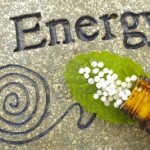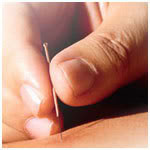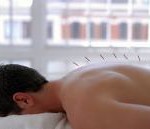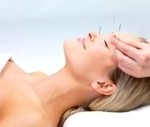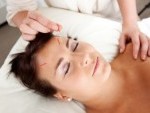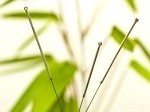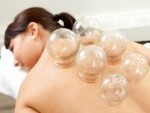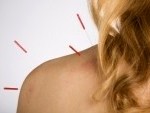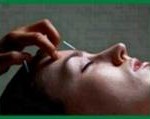About Acupuncture.
What Is Acupuncture and How Does It Work?
Acupuncture treatment involves the careful insertion of extremely fine needles into locations on the body known as acupuncture points. Ancient Chinese acupuncture maps reveal a unique system of specialized points running along acupuncture channels that feed energy to the organs of the body.
Acupuncturists refer to these channels or lines as meridians. Traditional Chinese Medicine teaches that the placement of acupuncture needles into specific acupuncture points affects the movement of Chi, a unique form of life energy, which flows through the meridian channels to nourish and support the various organs of the body and Although this “energy flow explanation” for acupuncture has long been acceptable to practitioners of Traditional Chinese Medicine, it does not set well with western medicine.
However in the last 20 to 30 years there has been hundreds of clinical trials on acupuncture world wide, showing acupuncture to work extremely well and in many cases superior to surgery and pharmaceuticals combined, this success led to the world health organization doing an audit on all acupuncture clinical trials, and from this the world health organization compiled a list of over 90 health conditions acupuncture successfully treats with high level evidence.
Nowadays even your next door neighbour has heard of and probably even tried acupuncture treatment. Yet in spite of increasing acceptance, western doctors still debate and speculate how and why acupuncture works at all, even in the face of clinical studies proving its efficacy beyond a doubt.
Medical historians have found records documenting the existence of traditional acupuncture treatments in China dating back as far as 5000 years. It was not until the early 1800’s, though, that traditional acupuncture treatment made an appearance in western medicine. Western doctors and researchers who have studied acupuncture have tried to explain the efficacy of acupuncture in terms of nerve-related, bio-chemical-related, and even psychologically related mechanisms. They have tried to “fit” acupuncture into the mechanistic medical model of the body that still occupies a major position in the practice of today’s western medicine.
When report’s of acupuncture’s ability to relieve pain and its use in anaesthesia during operations, made front page news in the New York Times in the early 1970s, doctors in the United States were either surprised or inclined to believe acupuncture’s benefits were due to a placebo effect. If a new pain relieving drug is tested, it is usually compared with a placebo pill or injection in order to distinguish how much of the new drug’s effects are merely due to a patients belief in the healing power of the medicine.
Western science knew that placebo’s, as simple sugar pills or saline injections, could produce therapeutic improvements in more than 30% of patients who were given them in place of real drugs. Therefore, it was easy to see how many doctors would believe in the power of placebo before changing their medical thinking to accept the reality of life energies flowing through the body.
Having never been educated on meridians and acupuncture points in their medical anatomy courses; Western doctors dismissed the Chinese doctor’s claims of manipulating Chi flow in the body. It was much easier to assume that the Chinese population had been brought up to believe in the power of acupuncture as a healing modality and that this powerful belief was responsible for any of acupuncture’s therapeutic effects.
But one of the problems with attributing all of acupuncture’s therapeutic benefits to the placebo effect was the fact that veterinarians in China had used acupuncture successfully to treat animals. Animals don’t understand the placebo effect, after all it is difficult to believe that horse’s, cows or other farm animals could believe in the power of the needle as a healing tool!
Many Western scientists sought to fit acupuncture’s effects into the realm of established human physiology. In the early 1970s, two researchers, P. Wall and R. Melzac, put forth the idea that acupuncture pain relief might work by stimulating nerves in the skin to affect the flow of pain impulses to the brain. The researchers hypothesized that the insertion of acupuncture needles into areas of the body rich in nerves might send a series of signals to the spinal cord, where there was a gate, that if closed, could turn off the flow of pain- message carrying nerve impulses traveling to the brain. The theory was known as the “gate control theory’ and was initially thought to be more plausible than the concept of meridians and acupuncture points.
As it turned out the gate control theory did not explain acupuncture’s many other therapeutic effects. However, researchers did discover that you could indeed shut off the flow of pain impulses to the brain, all you had to do was influence pain carrying nerves traveling through the spinal cord by using electrical stimulation. Based on this theory, neurosurgeon Dr. Norman Sheally developed the dorsal column stimulator, an implantable electrode system that was surgically attached to the spinal cord. It was quite effective in managing certain types of chronic pain and later, the neurosurgical procedure became unnecessary, as one could achieve similar pain relief through electrically stimulating nerves in the skin to achieve the desired effect. Thus, Transcutaneous Electrical Nerve Stimulator’s better known as TENS devices were born and have been used for treating chronic pain ever since. Unfortunately though, why acupuncture worked was still a mystery to Western science.
During the period of the late 1970s, research on acupuncture’s mechanism of action began to move away from nerves and focused instead on hormones and neurochemicals. Neurological researchers had recently discovered the powerful naturally reoccurring chemicals in the body known as endorphins. Endorphins behaved like the narcotic drugs opium and morphine by binding to opiate receptors throughout the nervous system thus endorphins were found to produce their pain relieving effects.
Pretty soon acupuncture researchers sought to connect acupuncture pain relief with the release of endorphins. Dr Bruce Pomeranz, working at the University of Toronto, could block the effects of traditional acupuncture analgesia ( pain relief ) by pre-treating them with a drug called naloxone. Naloxone was a medicine that was known to block the effects of endorphins in the body and sure enough acupuncture’s pain relief could not be blocked in the Naloxone –treated rats.
This finding suggested that endorphin release caused by traditional acupuncture needle stimulation was indeed an important mechanism behind acupuncture’s pain relieving effects. Since the initial research seemed promising, Pomeranz and others began to study the effects of electro acupuncture (electrically stimulating acupuncture points) on pain relief in rats. As Pomeranz proceeded, he soon found that Naloxone did not always work as predicted in blocking pain relief, especially when he varied the oscillating electro acupuncture current from low to high pulsing frequency. It seemed other Neuro-chemicals, such as Serotonin must be involved in high frequency acupuncture pain relieving effects, thus complicating the picture of acupuncture analgesia.
Another big problem with trying to attribute acupuncture’s effects only to endorphins or serotonin changes in the nervous system was the fact that acupuncture has been used in China for many years to treat many non-painful conditions, such as infectious diseases and chronic degenerative disorders of different organ systems. For instance, even the “barefoot doctors of China” that treated Mao Tse-Tung’s Red Army during the early 1930s used acupuncture effectively to treat illnesses like malaria. Time and time again, the numerous examples of successful treatment via acupuncture indicated that this ancient “needling therapy” defiantly was more complicated than Western science ever suspected.
While researchers in the West were busy investigating acupuncture’s neuro-chemical basis, Soviet scientists were taking a very different approach. In the early 1970s, Russian researchers noted that acupuncture points had unique electrical characteristics that distinguished them from surrounding skin. There was a ten to twenty fold drop in electrical skin resistance over acupuncture points that could easily be measured using conventional electrical recording equipment. This drop in electrical resistance meant that acupuncture points also conducted weak electrical currents more easily.
From this finding, Russian scientists developed the first hand held electrical acu-point locators that could reliably locate acupuncture points in the skin based upon lowered electrical skin resistance. The acupuncture point locators were a boon to acupuncture research. In fact, soon after their creation, another theory as to why acupuncture works was proposed. Some researchers went as far as to suggest that the healing effects of acupuncture point stimulation by classical acupuncture needle insertion was really due to a phenomenon known as the “current of injury”. Scientists have long been aware of an electrical phenomenon that occurs whenever tissues of the body are traumatized or undergo microscopic damage. For example, when skin cells are pierced, they begin to leak electrically charged ions into the surrounding tissues. So when the skin is pierced by a metallic acupuncture needle, a weak electrical battery like effect is created. We call this weak electrical current the current of injury.
The current is known to create a healing response from nearby cells. It was then theorized that stimulation of local tissues by the current of injury, created by acupuncture needles piercing the skin, was the true source of acupuncture’s healing effects. While this information is potentially valid for certain types of acupuncture treatment, it does not explain how stimulating acupuncture points with low level, non-piercing lasers, could achieve the same therapeutic effects as needle stimulation of acupuncture points. Again the mystery of how acupuncture worked was not totally resolved. The fact that acupuncture points posses electrical characteristics that distinguish them from surrounding skin suggests that there should be something automatically unique about acupuncture points.
When European and American scientists sought to study acupuncture points by dissecting cadavers and observing slices of acupuncture point tissues under the microscope, they noted that these regions were rich in nerves and blood vessels. Unfortunately, no one in the West seemed to be able to microscopically identify anything remotely resembling meridians connecting the acupuncture points. However anatomical acupuncture point research (AAPR) in the Far East eventually seemed to provide the missing link in identifying the existence of true anatomical meridians.
Much earlier, in the 1960’s a Korean researcher by the name of Dr. Kim Bong Han, had claimed to have developed special tissue-staining techniques that allowed him to identify meridians. Under the microscope, these meridians appeared as tiny micro-tubular structures traveling beneath the skin and throughout the organs of the body. In an attempt to identify meridian pathways, Dr. Bong Han injected radioactive tracers into the acupuncture-points of rabbits. Following acupuncture point injection, he found that the tracers always remained highly localized and concentrated in this unique micro tubular meridian system.
Remarkably, the meridian followed the same pathway shown in ancient vetnary acupuncture diagrams of rabbit meridians. Many Western scientists found the Korean claims difficult to believe, and thus ignored Bong Han’s findings until the early 1980s, when two French researchers, Dr’s Pierre De Vernejoul and Claude Darras, tried the radioactive tracer experiment again, but this time on volunteers. A radioactive product called technetium (a common radioactive isotope used in bone scans and thyroid scans) was injected into acupuncture points of the volunteers and special scanning equipment was used to non-invasively observe the movement of technetium away from the injection site. In order to make sure the doctors were really investigating meridians and not lymphatic channels or blood vessels, some participants were given technetium injections into adjacent non acupuncture point areas of the body as well as into nearby lymphatics and blood vessels.
When non-acupuncture point, blood vessels, or lymphatic channels were injected, the radioactive tracer tended to diffuse outwardly from the main injection site and formed small circular type patterns. However, when true acu-points were injected, the radioactive technetium followed the exact same pathways as the acupuncture meridians described and illustrated in several, hundred-year old acupuncture charts of the human body.
Even more amazing was the fact that when an acupuncture needle was inserted into a distal acu-point along the same meridian and then twirled (a distal point is an acupuncture point that is some distance away from the area of pain and twirling means the needles are stimulated by hand) it produced a change in the rate of flow of technetium through the meridian. In other words, needle stimulation of an acupuncture point on the meridian changed the flow rate of “something” (including the technetium tracer) along the meridian channel. This research provided the first believable evidence supporting the ancient Chinese claim that acupuncture not only worked on meridian channels but also stimulated the flow of energy through those channels. It seems that acupuncture became a little less mystical as a result of Darra’s and De Vernejoul’s work.
In another recent technological verification of acupuncture meridians, Dr. Zang-Hee Cho, a physics professor at the University of California in Irvine, found an amazing correlation between needle point stimulation in the body and the activation of specific areas in the brain. Using a special brain imager known as functional MRI, Cho studied the brain activity of volunteers who received classical acupuncture using points on the feet. These acupuncture points occurred along the urinary bladder meridian, a channel that acupuncturists say travels from the outside of the foot, up the legs and spine over the head and all the way to the eye region. To Cho’s amazement, needling the points on the foot that were said to stimulate the eyes caused the visual cortex, in the brain region associated with vision, to light up in all the volunteers tested. Inserting an acupuncture needle into a specific acupuncture point on the foot had the same effect on the brain as shinning a torch into a person’s eyes!
As a control, acupuncture needle point stimulation of nearby non-acupuncture point skin regions in the foot failed to produce any response. This was another verification of how treating one part of the body produced a distant organ effect, similar to what is predicted by classical Chinese meridian theory. Based on Cho’s findings, it was suggested that there was indeed some previously unknown physiological pathway connecting the feet to the eyes, just as the ancient Chinese texts had shown in their acupuncture meridian maps and charts of the human body.
While the American and French research does not necessarily prove the existence of chi, it does validate the existence of acupuncture meridians as discrete anatomical pathways running through the body as well as the specific acupuncture points along these channels.
According to acupuncture theory, illness is ultimately caused by a disturbed energy state (an imbalance between opposing forces known as yin and yang) or by an abnormal flow of chi moving through specific organ-linked meridians in the body. Since the meridians are thought to supply life energy to each of the organ systems, an excessive or diminished flow of chi to any organ would result in abnormal organ function and ultimately lead to physical disease. Also the diminished flow of chi energy could result in an increased susceptibility to external disease-causing agents such as harsh environmental conditions, bacteria and viruses, toxic substances, and the like.
Needle stimulation of acupuncture points seems to act like a regulatory key that selectively turns up or down the rate of chi flowing through the acupuncture point valves. The valves in turn act like power rely stations along the body’s meridian channels or life-energy distribution networks that run through the body. In classical acupuncture, either one of two different needle stimulation techniques, known as tonification or sedation (or dispersion), may be selected by the practitioner. The techniques tend to increase or decrease, respectively, the chi’s energy along selected organ-linked meridians and the decision to stimulate or disperse is based on the TCM diagnosis as to whether the patient has an excess condition or an deficiency condition. One of the two needle stimulation techniques will be used by the TCM practitioner and is determined only after careful study of a patient’s case and analysis of the type of energy imbalance the person has and the technique needed to rectify and restore health to the patient.
This explanation is really a gross oversimplification of acupuncture. But it does provide a clearer idea of how classical Chinese medicine views acupuncture mechanism of action compared with other neurological, bioelectrical, and biochemical theories put forth to explain the physiological effects of acupuncture. Considering the fact that modern nuclear technetium scans have actually verified the existence of meridian pathways in the body.
In the last 20 years or so the clinical evidence in favour of acupuncture in the form of trials have shown acupuncture’s effectiveness in treating a wide variety of health conditions and the World Health Organisation (WHO) in 2003 have listed over 90 specific health syndromes in which acupuncture works well and in some cases, better than surgery and conventional medicine combined and more trials are constantly being carried out in various parts of the world.
It is also important to understand that Western science, generally does not except evidence alone, that shows a therapy to work even although clinical trials back its efficacy up, Western science also insists on an explanation of how this is achieved and until then Western science refuses to fully accept clinical evidence alone. However from the point of view of the patient, it is not important to know how acupuncture works, it is only important to know that it does. So why not give it a try the next time you feel under the weather.
Regardless of your medically diagnosed condition natural medicine and acupuncture has something to offer.
If you would like to find out if acupuncture can help your health and wellbeing then call or text to 0410094602 or email us via our contact page to discuss your requirements or to find out more about acupuncture please go to our FAQs page. Alternatively give acupuncture a try and make an appointment now.
Best of health
Paul Neilson. CMP. L.Ac. ND. DHM. RT.
Our Acupuncture clinic is convenient for the following Perth suburbs:
Ascot. Ashfield. Bassendean. Bayswater. Beechboro. Belmont. Bentley. Burswood. Cannington. Carlisle. Como. Dianella. East Perth. Forrestfield. Guildford. Highgate. Highwycombe. Inglewood. Kalamunda. Kewdale. Lathlain. Leederville. Lesmurdie. Maylands. Midland. Morley. Mt Lawley. Noranda. North Perth. Perth. Redcliffe. Rivervale. South Perth. St James. Subiaco. Welshpool. West Perth. Tuart Hill. Yokine. Victoria Park. vic park.

